
The Gato class of submarines were built for the United States Navy and launched in 1941–1943. Named after the lead ship of the class, USS Gato, they were the first mass-production U.S. submarine class of World War II.

Grog is a term used for a variety of alcoholic beverages.

The daiquiri is a cocktail whose main ingredients are rum, citrus juice, and sugar or other sweetener.
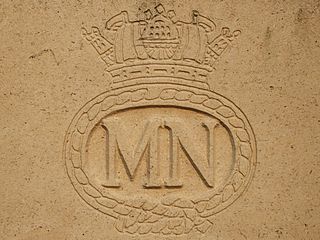
The British Merchant Navy is the collective name given to British civilian ships. In the UK, it is simply referred to as the Merchant Navy or MN. Merchant Navy vessels fly the Red Ensign and are regulated by the Maritime and Coastguard Agency (MCA). King George V bestowed the title of "Merchant Navy" on the British merchant shipping fleets following their service in the First World War; a number of other nations have since adopted the title. Previously it had been known as the Mercantile Marine or Merchant Service, although the term "Merchant Navy" was already informally used from the 19th century.

USS Barb (SS-220), a Gato-class submarine, was the first ship of the United States Navy to be named for the Barbus, a genus of ray-finned fish. She compiled one of the most outstanding records of any U.S. submarine in World War II. During her twelve war patrols, Barb is officially credited with sinking 17 enemy vessels totaling 96,628 tons, including the Japanese aircraft carrier Un'yō. In recognition of one outstanding patrol, Barb received the Presidential Unit Citation. On her twelfth and final patrol of the war, she landed a party of carefully selected crew members who blew up a train, the only ground combat operation in the Japanese home islands.

HMS Uganda was a Second World War-era Fiji-class light cruiser launched in 1941. She served in the Royal Navy during 1943 and 1944, including operations in the Mediterranean, and was transferred to the Royal Canadian Navy as HMCS Uganda in October 1944. She served in the Pacific theatre in 1945 and was put into reserve in 1947. When she was reactivated for the Korean War in 1952 she was renamed HMCS Quebec. She was decommissioned for the last time in 1956 and scrapped in Japan in 1961.

Admiral of the Fleet Peter John Hill-Norton, Baron Hill-Norton, was a senior Royal Navy officer. He fought in the Second World War as gunnery officer in a cruiser operating on the Western Approaches and in the North Sea taking part in the Norwegian Campaign, then in a cruiser taking part in the Arctic convoys and finally in a battleship operating in the Eastern Fleet. After the War he commanded a destroyer and then an aircraft carrier. He served as First Sea Lord and Chief of the Naval Staff and then Chief of the Defence Staff in early 1970s. In the latter role he gave the final commitment to Project Chevaline, the Polaris missile improvement programme. He went on to be Chairman of the NATO Military Committee.

Admiral Edward Vernon was a Royal Navy officer and politician. He had a long and distinguished career, rising to the rank of admiral after 46 years service. As a vice admiral during the War of Jenkins' Ear, in 1739 he was responsible for the capture of Portobelo, Panama, seen as expunging the failure of Admiral Hosier there in a previous conflict. However, his amphibious operation against the Spanish port of Cartagena de Indias was a disastrous defeat. Vernon also served as a Member of Parliament (MP) on three occasions and was outspoken on naval matters in Parliament, making him a controversial figure.

Beer Day is the term applied to an event where a United States Navy or Military Sealift Command vessel's personnel are issued, and authorized to consume, beer.
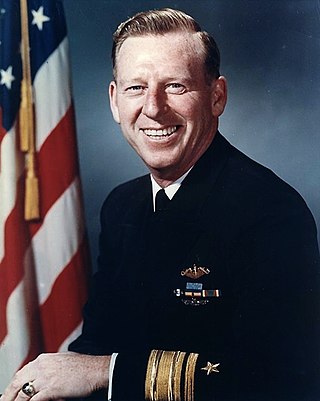
Eugene Bennett Fluckey, nicknamed "Lucky Fluckey", was a United States Navy rear admiral who received the Medal of Honor and four Navy Crosses during his service as a submarine commander in World War II.
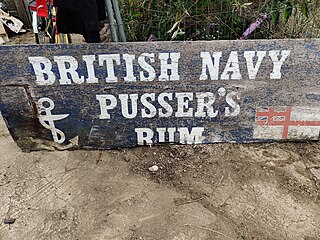
Pusser's Rum is a brand name of rum produced by Pusser's Rum Ltd., based in the British Virgin Islands. Nine years after the Royal Navy discontinued the daily rum ration in 1970, the company was founded to produce the rum from the original Royal Navy recipe, using a blend of five West Indian rums.
Provisioning for sea was crucial in the 19th century due to the lack of modern conveniences such as refrigeration, freeze-drying and canning. Most foodstuffs and liquids such as spirits, molasses, vinegar, and water, were shipped in casks, the balance in wooden crates and other suitable packing materials.

The Royal Naval Auxiliary Service (RNXS) was a uniformed, unarmed, civilian volunteer service, administered and trained by the Royal Navy to operate in the ports and anchorages of the United Kingdom in an emergency. Although the abbreviated title would logically have been RNAS this abbreviation had long been taken by the various Royal Naval Air Stations, so RNXS it was. It maintained training units, and vessels at most major ports in the UK. and was formed in 1963 from the amalgamation of the Royal Naval Mine-watching Service (RNMWS) and Admiralty Ferry Crew Association in response to the perceived nuclear threat to British ports. The service was disbanded on 31 March 1994 due to Ministry of Defence (MOD) cuts. Most vessels from its fleet were transferred to the Royal Navy or sold, with the exception of XSV Loyal Volunteer, which was struck by a ro-ro ferry while berthed in Ipswich Harbour and was later scrapped.

A fleet review or naval review is an event where a gathering of ships from a particular navy is paraded and reviewed by an incumbent head of state and/or other official civilian and military dignitaries. A number of national navies continue to hold fleet reviews. Fleet reviews may also include participants and warships from multiple navies.
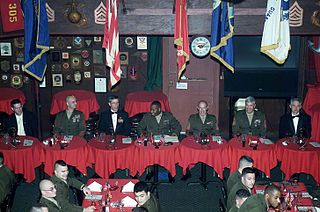
Dining in is a formal military ceremony for members of a company or other unit, which includes a dinner, drinking, and other events to foster camaraderie and esprit de corps.
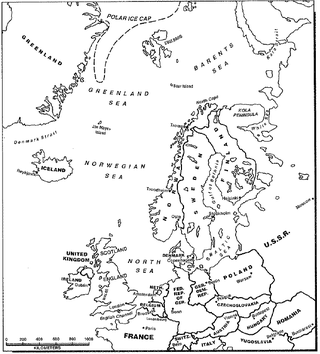
Exercise Mainbrace was the first large-scale naval exercise undertaken by the newly established Allied Command Atlantic (ACLANT), one of the two principal military commands of the North Atlantic Treaty Organization (NATO). It was part of a series of NATO exercises jointly commanded by Supreme Allied Commander Atlantic Admiral Lynde D. McCormick, USN, and Supreme Allied Commander Europe General Matthew B. Ridgeway, U.S. Army, during the fall of 1952.
The combination of the Bravo and Zulu nautical signal flags, i.e., Bravo Zulu, also referred to as "BZ," is a naval signal, typically conveyed by flaghoist or voice radio, meaning "Well Done" with regard to actions, operations or performance. In addition to the British Royal Navy, it has also been used as part of vernacular slang within the U.S. Navy, NATO, and other Allied naval forces. It can be combined with the "negative" signal, spoken or written as NEGAT, to say "NEGAT Bravo Zulu" to convey "not well done" for a given action.

Rum is a liquor made by fermenting and then distilling sugarcane molasses or sugarcane juice. The distillate, a clear liquid, is often aged in barrels of oak. While strongly associated with the Caribbean to this day due to its Barbadian origin, rum is nowadays produced in nearly every major sugar-producing region of the world, such as the Philippines, where Tanduay Distillers, the largest producer of rum worldwide, has its headquarters.

Black Tot Day was the last day on which the Royal Navy issued sailors with a daily rum ration.

The rum ration was a daily amount of rum given to sailors on Royal Navy ships. It was abolished in 1970 after concerns that the intake of strong alcohol would lead to unsteady hands when working machinery.



















